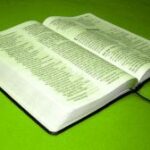Recently I wrote and submitted to Associated Content an article about each of the first five books of the Old Testament, but it occurred to me that I should have begun with an overview of the types of books found in the Old Testament. That way, a reader of each article can place the book in its proper category and location within the Old Testament.
The Categories of the Books. It is important to emphasize at the beginning that the Old Testament is not presented to us in a straight-forward, consecutive narrative. Instead, Bible scholars have long recognized that the Old Testament consists of 39 books arranged by type of writing, although there is some crossover between the categories. For example, history is not limited to the books classified as history. While the first five books are known collectively as Torah or Law, they do contain a great deal of history.
Here are the four categories of Old Testament books:
The Torah-The first five books of the Old Testament
The History books-The next 12 books
The Poetical books or, simply, the Writings-The five books that follow the history books
The Prophets–The final 17 books of the Old Testament
[Note: Some scholars would combine the five books of the Torah with the 12 books of history, and call it all history. Even those scholars, however, recognize that the first five books form their own unity.]
The Torah. Genesis through Deuteronomy. The Torah (or the Law or the Way) is, in the eyes of the Jews, the heart of what Christians call the Old Testament. The Torah begins by assuming that there is a God who creates the world. It continues with the coming of sin into the world and the worldwide consequences of that sin. A major figure in the Torah is Abraham who becomes the father of the Jewish nation. Another major figure is Moses who leads the Jews out of slavery in Egypt to the border of their new home in the Promised Land of Canaan. In order to shape the Jews into a people who live as God’s people, God gives the nation the Ten Commandments and hundreds of other rules and regulations that, if followed, will set the Jews apart from the other nations. God also provides plans for the Tabernacle, the portable worship center, in which God meets with the people. After 40 years of wandering in the desert, the Jews, at the end of Deuteronomy, stand on the border of the Promised Land, ready to move in and conquer it.
The History Books. Joshua through Esther. This is not history as you would read it in a traditional book of history; this is history written from the perspective of God’s work in the life of the Jewish nation. According to this history, the Jews did not act on their own, but in response to the call of God and the commandments and orders of God. Reading the books from this perspective leads to some theological stress. Why, for example, would God order the total extermination of the nations of the Promised Land when the Jews came into it? While we may struggle with answering that question and many others, the Jews saw themselves as God’s people under the lordship of God. The books of history show the Jews entering and conquering the Promised Land, and continue through the period when the nation was ruled first by judges who ruled in the name of God, then by kings, and then the split into two nations and how those two nations fared under their own kings and under the attacks of powerful outside nations.
The Poetical Books (the Writings). Job through the Song of Solomon. These books are written in the form of poetry, a form that is followed in most modern versions of the Bible. There is a wide variety of subjects presented in the Poetical books. Job struggles with the problem of bad things happening to a good person. The Psalms have been known as the “prayer book” of the Bible because they are words addressed to God out of anger, hope, praise, discouragement, and other moods. Proverbs contains practical advice for living a good life. Ecclesiastes deals with some of the popular ways of living and discards them all in favor of living a life under God. The Song of Solomon appears to be a human love story, but is often interpreted as a passionate love story between God and the people of God.
The Prophets. Isaiah through Malachi. The prophets were people through whom God spoke words of warning, rebuke, and encouragement to the Jews, and through whom God sometimes predicted the future for individuals or for the nation. The 17 books of the prophets are divided into two subgroups: the Major Prophets and the Minor Prophets. The division is not on the basis of importance, but on the basis of the length of the books, the Major Prophets being much longer than the Minor Prophets.
The amazing thing about the 39 books of the Old Testament is how they all fit together, even though they were written and/or edited by many different people over a long period of time. The unifying factor is, of course, the presence and working of God. In fact, God is mentioned in every one of the 39 books, except for the book of Esther, and even there the hand of God is evident in the events that take place. For us, as well as for the people who lived in Old Testament times, the message is simple: there is a God who is active in human history.





